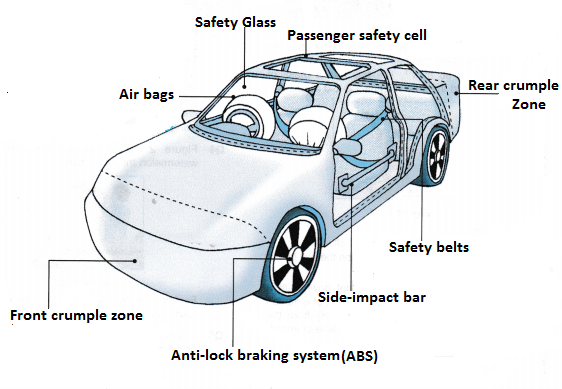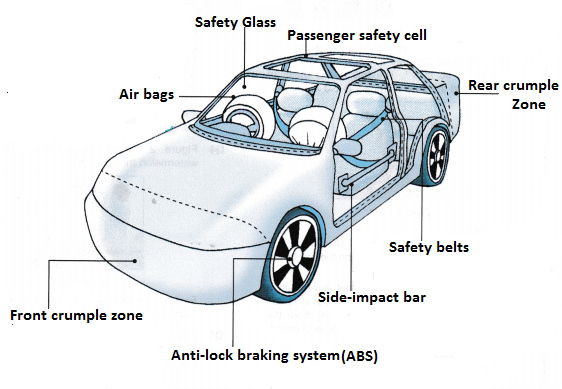The invention of the automobile was without a doubt a game-changer. Specifically, the automobile changed the mobility of society and allowed both things and people to travel at record speeds. Overall, the automobile created new social and economic opportunities and overall changed the American landscape, local and international commerce.
Despite the fact that automobiles were highly beneficial to everyone, their widespread use did not come without significant risks. Specifically, in the early 1900s, there was a record number of deaths and injuries caused by automobile accidents. From the dangers of glass that broke quickly and easily to the lack of structural protection, manufacturers were tasked with inventing safer alternatives to car manufacturing so that society could continue to enjoy its benefits. Additionally, by the 1910s, reckless driving, speeding, and collisions were unfamiliar problems that legislatures worldwide had to deal with.

Today traveling by car is much easier than it was before, and it is also safer. Although automobile accidents can’t be completed prevented, as technology continues to evolve, the risk of getting into car crashes has significantly diminished with the introduction of advanced safety features, some of which we will discuss below.
Notable Safety Features Introduced in the Early 1900s
It should go without saying, but a lot has changed since the first automobile was invented in the latter half of the 1800s.
In the early 1900s, automobiles saw the introduction of the first known wiper blades (1903) by an independent woman who didn’t even drive.
In 1911, an engineer named Ray Harroun invented the first known rearview mirrors. Ray’s invention took place in the spring of 1911, on May 30, before racing in the very first Indy 500. Before this invention, car racers had to ride with another person, who would tell them where other drivers were driving in the race. Harroun got rid of his driver and instead installed rearview mirrors instead. Elmer Berger was the first to patent this idea in 1921 and is often erroneously credited as the inventor of rearview mirrors and not Harroun.
In the 1920s, safety glass and laminated glass were introduced to prevent the car’s glass from shattering upon any sort of impact to the vehicle. By the 1930s, auto glass was tempered.
General Motors conducted its first crash test in 1934, which was a game-changer in how manufacturers could evaluate a vehicle’s safety. Crash tests eventually became mandatory for all vehicles in 1994.
Lastly, in 1947, American Tucker built the first padded dashboard.
The 1950s
The Introduction of Airbags and Seat Belts
By the 1950s, several significant inventions were introduced in the automobile industry, most of which are still used today.
Notably, in 1951, airbags were conceived. At that time, the airbag could be activated by the driver or if the vehicle experienced contact on its bumper. By the 1970s, Airbags were available in some General Motors models. The first sensor-activated airbags can be traced back to 1968. Despite its great safety value, GM and Ford spent years lobbying against airbags being legally mandated in all vehicles. However, despite their efforts, by the 1990s, airbags were found in the vast majority of American-made cars. However, Airbags only became mandatory in vehicles in 1998.
In 1959, Volvo conceived the first three-point seatbelt, which strapped over the shoulder and lap as an extra layer of protection for drivers. This feature turned out to be one of the best safety inventions for automobiles and forever changed seatbelt safety in automobiles. By 1995, all states in the US except (New Hampshire) had some form of law requiring adults to wear seat belts while driving or riding in an automobile.
The 1960s
The 1960s saw a slew of federal legislation and regulations regarding car manufacturing and safety feature requirements.
Notably, in 1964 cars sold to consumers after January 1 were required to be equipped with front seat belts in the US.
In 1967, front headrest became mandatory in an effort to reduce whiplash during a collision.
By 1968, the initial Federal Motor Vehicle Safety Standards were launched, which subsequently makes side marker lights mandatory, along with the and front shoulder belts.
The 1970s
Anti-locking Braking Systems
The earliest known braking systems to vehicles only applied pressure to the rear wheels. As such, if there were ever an emergency, the wheels would then lock causing the car to come to a dangerous halt and sometimes word. The type of anti-locking brakes or ABS was first invented for aircrafts in order to prevent the wheels from locking when the aircraft was landing. This technology was first introduced in automobiles around the 1970s. By the late 1980s, this became the standard technology. The APS system allows the driver to maintain control of the wheel when the brake is applied on slippery or wet pavement.
1990 and Beyond
The car industry saw an increased number of electronic systems conceived for new vehicles beginning in the 1990s.
Electronic Stability Control (ESC)
ECS prevents drivers from losing traction by applying brakes to each when the driver dies a maneuver on difficult terrain or pavement. This technology was first introduced in 1983. However, in 1995, Bosch and Mercedes-Benz introduced the technology commercially, and it has since become standard in most automobiles.
Autonomous Safety Features
Many luxury vehicles have become equipped with automatic brake systems, which can sense traffic and even automatically brake for the vehicle if the driver is close to hitting a person or object. Similarly, many luxury vehicles now come standard with lane assist technology. Specifically, this technology will send audio and/or visual alerts to the driver to help them stay in their lane if they unexpectedly drift out of their lane without the use of a turn signal.
Rear View Cameras
Rear few cameras were first used in a Buick concept car in 1956. They first became introduced the production of vehicles around 1991. Today, rearview cameras are a standard feature in most vehicles. Rearview cameras prevent backup collisions by helping alleviate the rear blind spot. It also helps prevent pedestrian collisions by being able to see when someone is walking behind their car. Many exams rearview cameras come equipped with safety audio and/or visual indicators when the camera detects that a person or item is in the vehicle’s rear blind spot.
Final Thoughts on the Evolution of Automobile Safety
Overall, automobile safety features continue to evolve and are encouraged. Drivers of automobiles that are viewed as safer are regularly rewarded by their insurance company with lower insurance rates, annual premiums, and additional discounts. As technology moves towards electric and self-driving automobiles, it’s exciting to see how automobile safety will evolve even further.





